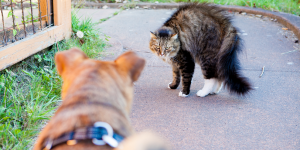Dog Behaviour – What is Trigger Stacking?
A trigger is something which causes a dog to display signs of fear, or stress. It can be unique to each dog, although there are common triggers such as fireworks, strange people, or dogs, visits to the vet, etc. Many dogs will have a unique set of triggers. Trigger stacking is as the phrase describes. Where one trigger, on top of another, causes the dog acute anxiety. Read our Holidays4Dogs article to find out more.
When it comes to triggers, each dog will have his own coping level. Otherwise known as the ‘threshold’, level in the field of behaviour. This threshold represents the point at which a dog can no longer cope with feelings of stress, or arousal. In human terms, we might describe it as being, ‘pushed over the edge’.
cope with feelings of stress, or arousal. In human terms, we might describe it as being, ‘pushed over the edge’.
It is also often described as, moving from one emotional state to another. Once this point is reached, dogs will enter a state of, ‘fight’, ‘flight’, or ‘freeze’. Some dogs may react aggressively – (fight).
Others may bolt, or attempt to pull out of their harness, or collar – (flight), while some, will simply shut down (freeze).
During any of these states, it will be impossible to distract the dog and, in most cases, they will not take food, or direction of any kind. Crucially, this ‘threshold’ may be reached more quickly in some dogs than in others. While some dogs may freak out at stranger in the distance, for example, others may only reach breaking point after a series of numerous triggers.
What is ‘trigger stacking’?
This is when dog is subjected to many triggers all at the same time, or one after the other in quick succession. While many dogs can cope easily with one, or two triggers, once they begin to stack up, – the dog can enter the fight, flight or freeze state. 
These triggers may not always be negative. However, if they cause the dog to become highly aroused, this can impact on the dog’s resulting behaviour.
#Example 1.
Consider the dog who gets over-excited while playing with other dogs, or chasing cats. However, he is also fearful of men. One day, the dog may be over-stimulated by a cat crossing his path.
After this encounter, he may go on to play chase with other dogs in the park. At this point he seems happy.
On the way home, he is approached suddenly by an unfamiliar male stranger. In this situation, he may be more inclined to act aggressively, or fearfully.
#Example 2.
Think about a dog walking down a busy street. He appears to have always coped with this. However, he experiences heavy traffic such as thundering lorries, which he is very unsure about. He must then pass several strangers which he is uncomfortable with.
Next, he sees another dog, which he likes, but this further increases his arousal levels. Finally, an unfamiliar person walks up close to him. This pushes him over the edge and he reacts aggressively, pulls away in fear, lies flat to the ground, or a combination of all three. This is an indication of trigger stacking.
When the dog goes beyond his comfort threshold, it can be assumed he has been feeling uncomfortable for some time before that.
Neurological responses.
When dogs are exposed to a trigger, their bodies activate a hormonal and neurological response.  Not surprisingly, this effect can last for many hours after a stressful event. It can last even longer if the dog has experienced many triggers all in one go.
Not surprisingly, this effect can last for many hours after a stressful event. It can last even longer if the dog has experienced many triggers all in one go.
Dogs can even react to trigger stacking if they are exposed to events over a number of days. Therefore, stress levels can add up over time. In some individuals, it can potentially create all sorts of behaviour issues. This may explain why some dogs can appear unpredictable.
Once the principles of trigger stacking are understood, it is possible to manage and prevent the dog from ever going beyond his coping threshold.
For people with reactive dogs, it’s an important concept to get to grips with. Understanding it can help your dog to cope with the human world much better. Remember also, it is not just negative experiences that can raise arousal levels, (like noisy traffic). Things the dog enjoys, such as playing with other dogs, can have the same effect and add to trigger stacking.
Conclusion.
Not all dogs behave this way – some dogs are ‘bomb proof’ and have very high coping thresholds. However, all dogs will benefit from owners who consider their dog’s mechanisms for coping in different situations. Crucially, this can prevent them from encountering negative experiences which may influence their future ability to deal with difficult situations.


